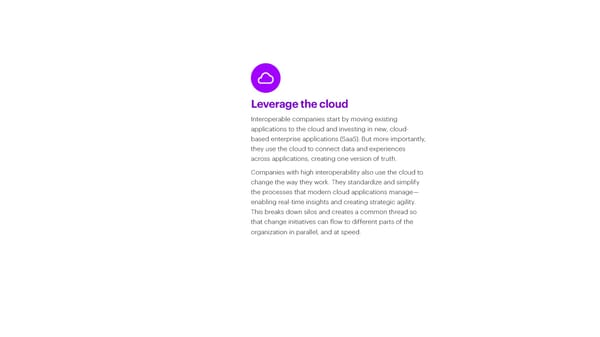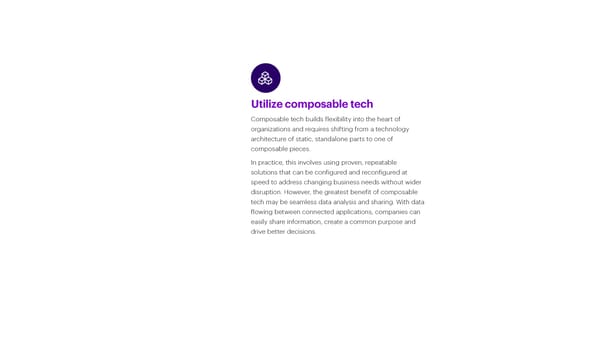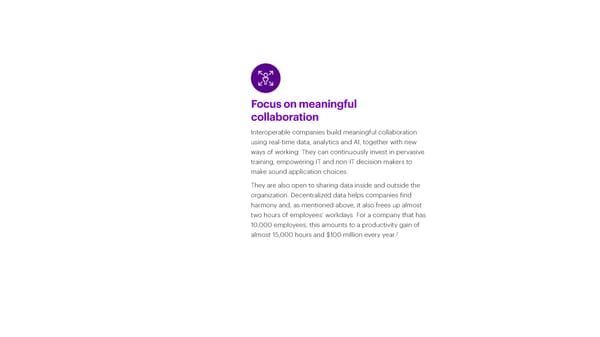Summary
Executive Summary of Value Untangled | Accelerating radical growth through interoperability
Accenture
Marketing
Interactive Content
Value Untangled
Technology
Interoperability
Sales
Agility
Cost
Value untangled Accelerating radical growth through interoperability Executive Summary From insights to action, the path to extraordinary value starts here.
Value angled Unt Assets L ibrary Click to Explore

This is a modal window.
This is a modal window.
This is a modal window.
This is a modal window.
This is a modal window.
This is a modal window.
Agility in times of uncertainty These companies have one thing in common: high interoperability, or the ability to make enterprise applications In an unpredictable world, the ability to quickly adapt to new work in conjunction with each other. In fact, companies with circumstances, adopt new technologies and otherwise remain high interoperability are 11% more likely to sustain compressed nimble allows companies to thrive. With the integration of these transformations. technologies, people and processes, companies can untangle value Interoperability Defined: from chaos and accelerate growth. To learn more about the value of agility, we surveyed 4,000+ C-suite Interoperability is when enterprise applications can respondents from midsize to large companies. We found that in easily interact with each other and exchange data. the last two years alone, one in two have had to transform multiple A seamless user experience across applications parts of their business at the same time or execute a single large creates a single source of data truth that aligns transformation much faster than ever before. We call this compressed everyone to common goals, leading to better transformation. decision making, human connections and insight generation.
Integrated enterprise applications enable businesses to move from siloed technology and fragmented data to connected solutions, Figure 1 Interoperability accelerates growth agility and resiliency. Companies with high interoperability unlocked up to five additional percentage points of revenue growth than low/no interoperability companies stuck in the technology status quo. And then comes growth. We found that companies with high interoperability grew revenue 6x faster than their peers with low Average revenue growth last FY (in %) interoperability (Figure 1) and are set to unlock an additional five percentage points in annual revenue growth. High Interoperability This is a significant long-term advantage: If two similar companies 6% start with $10 billion in revenue today, the company with high 5pp of additional growth due to platform exploration and interoperability interoperability would stand to make $8 billion more than the company with low interoperability over the next five years. Medium Interoperability That’s not all. We found that companies with high interoperability 4% were also: 3pp of additional growth due to platform exploration More efficient: 12 percentage points better at improving their supply Low / No Interoperability chain and operations. 6x 4x 1% More successful at CX: 16 percentage points better at reinventing the customer experience. Source: Accenture Research based on Survey data. More productive: 12 percentage points more likely to be successful Note: Additional growth rates due to increased platform exploration and seamless interoperability are estimates based on an econometric model such as Revenue Growth i= A x medium interoperability + B x high interoperability when improving employee productivity is a priority. +C controls + error, in which the baseline is the low/no interoperability group. Estimates include a variety of firm-specific controls including industry, country, size, technology spending and an interaction term between industry and country. A variety of robustness checks have been performed (i.e., scaling revenue growth by industry More sustainable: 4 percentage points more likely to be successful averages, by previous growth rates and the results holds. Survey sample= 4,053 firms in 19 industries and 23 at embracing sustainable business practices. countries. Revenue growth percentages have been rounded off to the nearest whole number. Last FY implies the latest annual company financials reported before February 2022.
Interoperability creates far-reaching value Figure 2 Real-world organizations untangling value via interoperability Interoperability creates a common language across critical By connecting technology, people and process, interoperability extracts value that’s applications and systems. This data synergy reduces often in sight, but tangled up in the organization. duplicative efforts, reveals hidden bottlenecks and builds better human connections, improving value drivers across industries and economic cycles. (Figure 2). Interoperability is now within reach Achieving lasting value with interoperability is possible due to three technology changes that make it simpler for organizations to configure and reconfigure applications as Interoperability needed—without overhauling their digital core: 1. Ubiquity of cloud: Many organizations have already moved to the cloud, giving them a common data layer that provides a single source of truth. 2. Improved application design: Modern applications are designed to share data, and they have simplified interfaces and support additional capabilities. 3. Low-cost applications: The large number of specialized applications on the market has reduced the cost.
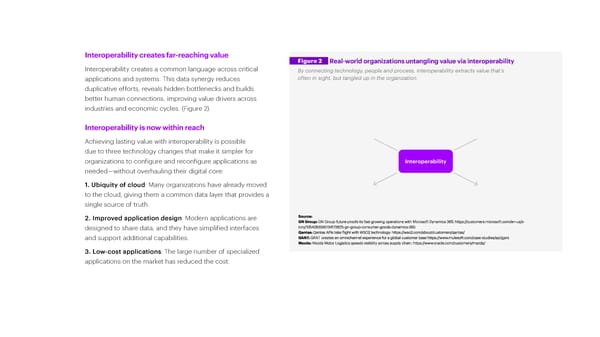
Plus, we found that leading companies are able to achieve high interoperability with just 2-4% higher IT and functional budgets directed at applications, while handling as many (if not more) diverse applications within their IT stack. But currently, only one in three companies is capitalizing on these advances to untangle the value trapped within their organization. These companies are racing past their competitors because they make high interoperability central to their overall business and technology strategy. GN Group hits play on enterprise interoperability Even before The New York Times declared its Jabra headset as the best on the market in spring 2021, GN Group, a global audio solution manufacturer, braced for a demand surge by integrating its business applications under a unified strategy. Sales had jumped 82% in the first quarter of 2021 on the heels of a 42% rise in 2020, when COVID-19 influenced millions to buy headsets for remote school and work. Company leaders knew this need would only grow with fast-changing consumer behavior—and that GN Group’s people and technology would play a critical role in 1 meeting the demand. Given the urgency, this transformation needed to happen quickly.
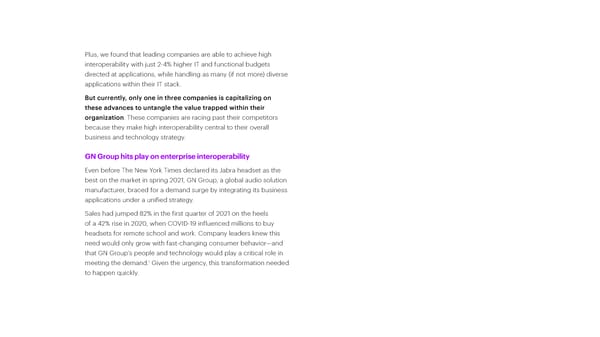
This is a modal window.
Using Microsoft’s cloud-based enterprise solutions, the company How to improve interoperability and thrive in uncertainty connected multiple functional applications to gain additional Our research uncovered the best practices and common pitfalls insights. This enabled parallel, rapid transformation in multiple C-suite respondents faced on their way to high interoperability, as business areas. Employees across the organization now make well as what enabled them to compress their transformation. Here’s decisions based on a single source of trusted data, and in real time. what we learned. (Figure 3). Barriers to Interoperability Today’s business and technology landscape can make reaching high Figure 3 How to improve your interoperability interoperability a challenge. To improve interoperability and compress transformation, companies must leverage the cloud, utilize composable tech and focus on meaningful collaboration. Most large enterprises have more than 500 applications, and plan Composable Tech to buy more from multiple vendors in the next two years. The longer Build repeatable solutions that can be these organizations wait to make themselves interoperable, the more configured and reconfigured at speed difficult it becomes to retrofit interoperability on an ever-growing to address changing business needs. application stack. Other businesses—60% of respondents in our study—are held back from improving interoperability because they struggle to align their application strategy with overall business goals. Another 57% cite lack of buy-in from senior leadership; 44% lack a clear ROI or business case; and 34% believe interoperability is simply too expensive. Companies with high interoperability also face these challenges. But Cloud Collaboration they cope with obstacles by finding alignment across the business, Use cloud as the foun- Focus on empowering dation for shared data employees with new digital acting early and making difficult decisions as needed. and experiences skills, trusted collaboration and across applications. shared definition of success.
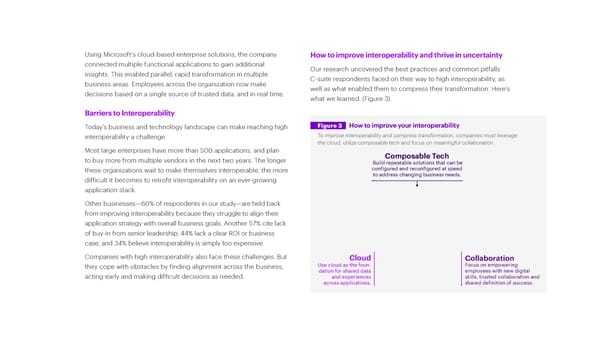
Leverage the cloud Interoperable companies start by moving existing applications to the cloud and investing in new, cloud- based enterprise applications (SaaS). But more importantly, they use the cloud to connect data and experiences across applications, creating one version of truth. Companies with high interoperability also use the cloud to change the way they work. They standardize and simplify the processes that modern cloud applications manage— enabling real-time insights and creating strategic agility. This breaks down silos and creates a common thread so that change initiatives can flow to different parts of the organization in parallel, and at speed.
Utilize composable tech Composable tech builds flexibility into the heart of organizations and requires shifting from a technology architecture of static, standalone parts to one of composable pieces. In practice, this involves using proven, repeatable solutions that can be configured and reconfigured at speed to address changing business needs without wider disruption. However, the greatest benefit of composable tech may be seamless data analysis and sharing. With data flowing between connected applications, companies can easily share information, create a common purpose and drive better decisions.
Focus on meaningful collaboration Interoperable companies build meaningful collaboration using real-time data, analytics and AI, together with new ways of working. They can continuously invest in pervasive training, empowering IT and non-IT decision makers to make sound application choices. They are also open to sharing data inside and outside the organization. Decentralized data helps companies find harmony and, as mentioned above, it also frees up almost two hours of employees’ workdays. For a company that has 10,000 employees, this amounts to a productivity gain of almost 15,000 hours and $100 million every year.2
Interoperability: Value Untangled Today’s companies must anticipate and respond to uncertainty as it happens, not when the opportunity has passed. This only happens when everything is integrated and interoperable, from the diverse technologies that power the business to the employees on the ground. One in three companies have the level of agility needed to untangle the value trapped in their organization, and race past their competitors in growth, efficiency and resiliency. Their secret? Using interoperability as the catalyst for total enterprise reinvention.
Authors Emma McGuigan Jan van den Bremen Brian McKillips Global Lead Europe Lead Growth & Strategy Lead Enterprise & Industry Enterprise & Industry Enterprise & Industry Technologies Technologies Technologies Emma McGuigan leads Enterprise & Industry Jan leads Enterprise & Industry Technologies in Brian leads Enterprise & Industry Technologies Technologies, which helps clients achieve Europe, which helps clients achieve enterprise- strategy, as well as the Connected Solutions enterprise-wide transformation by bringing wide transformation by bringing Accenture’s deep group. He helps businesses solve some of their Accenture’s deep technology, functional and technology, functional and industry expertise across greatest challenges by driving accelerated digital industry expertise across SAP, Microsoft, Oracle, leading platforms. He is a member of Accenture’s transformation and exploring new ways to employ Salesforce, Workday, Adobe and other leading Europe Management Committee (EMC) and technology to meet their business goals. platforms. For these IPS platforms, Emma oversees Accenture’s Global Leadership Committee (GLC). Accenture’s relationships, strategy and capabilities globally and across all industries. She is a member of Accenture’s Global Management Committee.
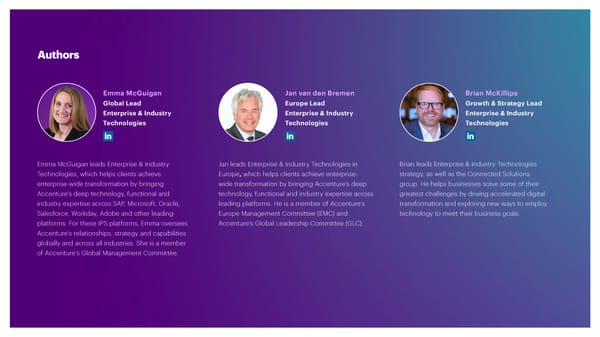
Authors Pradeep Roy Surya Mukherjee Project Team: Research Lead Research Lead Ajay Garg Global Europe Chiara Addis Technology Technology Ezequiel Tacsir Gargi Chakrabarty Jakub Wiatrak Krish Jhaveri Pradeep Roy is a Managing Director at Accenture Surya Mukherjee is a Senior Principal at Mariusz Bidelski and leads global Technology Research. He Accenture and Head of Technology Research for Mélina Viglino is most active on topics which explore the Europe. He has over two decades of experience Sandra Najem innovation potential of technology to drive as an advisor to platform providers and their Shachi Jain business reinvention and enable socio-economic users and has been quoted on the Wall Street Acknowledgments: transformation to create 360-degree value. Journal, ZDnet and Computer Weekly. His Salena Gallo interest lies in exploring the transformative Jennifer Cronin impact of technologies on industries, Shannon Mapp companies, and brands.
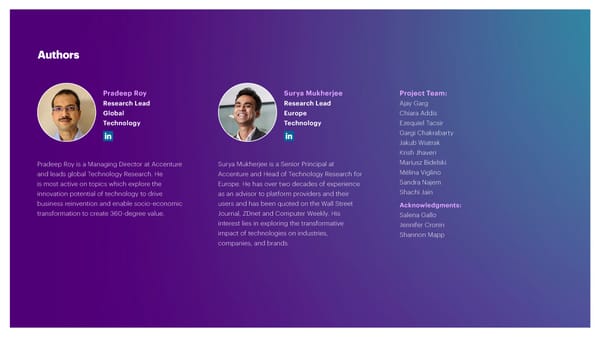
References 1 GN Group future-proofs its fast-growing operations with Microsoft Dynamics 365: https://customers.microsoft.com/en-us/story/1354283595134173825-gn-group- consumer-goods-dynamics-365 2 Based on average wages per hour data from US Bureau of Labor Statistics (https://www.bls.gov/news.release/empsit.t19.htm). Calculation: Productivity gain with interoperability x Average hours worked per day per employee (8 hrs) x No. of employees (10,000) x No. of working days in a year (260) x Average wages per hour ($32 as of June 2022 per US Bureau of Labor Statistics)
About Accenture About Accenture Research Accenture is a global professional services company with leading capabilities in Accenture Research creates thought leadership about the most pressing business digital, cloud and security. Combining unmatched experience and specialized skills issues organizations face. Combining innovative research techniques, such as data across more than 40 industries, we offer Strategy and Consulting, Technology science led analysis, with a deep understanding of industry and technology, our team and Operations services and Accenture Song — all powered by the world’s largest of 300 researchers in 20 countries publish hundreds of reports, articles, and points network of Advanced Technology and Intelligent Operations centers. Our 721,000 of view every year. Our thought-provoking research developed with world leading people deliver on the promise of technology and human ingenuity every day, serving organizations helps our clients embrace change, create value, and deliver on the clients in more than 120 countries. We embrace the power of change to create value power of technology and human ingenuity. and shared success for our clients, people, shareholders, partners and communities. For more information, visit www.accenture.com/research. Visit us at www.accenture.com. This content is provided for general information purposes and is not intended to be Copyright © 2022 Accenture. All rights reserved. used in place of consultation with our professional advisors. This document refers Accenture and its logo are registered trademarks to marks owned by third parties. All such third-party marks are the property of their of Accenture respective owners. No sponsorship, endorsement, or approval of this content by the owners of such marks is intended, expressed, or implied.

